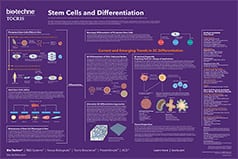Rho-Kinases
Rho-kinases (aka Rho-associated coiled-coil kinases or ROCKs) are serine/threonine kinases that are so called because they are thought to be activated by RhoA GTPases. They are modulators of processes involving cytoskeletal rearrangement, such as focal adhesion formation, cell motility and tumor cell invasion. ROCK inhibitors such as Y-27632 (Cat. No. 1254) are widely used in stem cell culture, for maintenance and differentiation protocols.
Rho-Kinase Inhibitors |
|
|---|---|
| Cat. No. | 产品名称/活性 |
| 7881 | CHDI 00580985 最新 |
| Potent and selective ROCK inhibitor; orally bioavailable and brain penetrant | |
| 7163 | Chroman 1 |
| Highly potent and selective ROCK 2 inhibitor; improves cell survival after cryogenesis | |
| 0541 | Fasudil hydrochloride |
| Inhibitor of cyclic nucleotide dependent- and Rho-kinases | |
| 4009 | GSK 269962 |
| Potent and selective ROCK inhibitor | |
| 2414 | H 1152 dihydrochloride |
| Selective Rho-kinase (ROCK) inhibitor | |
| 2485 | Glycyl-H 1152 dihydrochloride |
| Selective Rho-kinase (ROCK) inhibitor. More selective analog of H 1152 dihydrochloride (Cat. No. 2414) | |
| 5182 | OXA 06 dihydrochloride |
| Potent ROCK inhibitor | |
| 5061 | RKI 1447 dihydrochloride |
| Potent and selective ROCK inhibitor; antitumor | |
| 4118 | SB 772077B dihydrochloride |
| Potent Rho-kinase inhibitor; vasodilator | |
| 3667 | SR 3677 dihydrochloride |
| Potent, selective Rho-kinase (ROCK) inhibitor | |
| 4961 | TC-S 7001 |
| Potent and highly selective ROCK inhibitor; orally active | |
| 3845 | Thiazovivin |
| ROCK inhibitor; improves the efficiency of fibroblast reprogramming and induction of iPSCs | |
| 1254 | Y-27632 dihydrochloride |
| Selective ROCK inhibitor; inhibits ROCK1 (p160 ROCK) and ROCK2; stem cell freezing (cryopreservation) media component | |
| 7000 | Y-27632 in solution |
| Sterile-filtered 10 mM solution of Y-27632 pre-dissolved in water | |
There are two isoforms of ROCK, ROCK1 (aka ROKβ or p160 ROCK) and ROCK2 (aka ROKα), which share a high degree of structural identity in their kinase domains (92%). The two Rho-kinase isoforms have different patterns of tissue expression; ROCK2 expression is highest in the brain and in muscle, whereas ROCK1 has a ubiquitous tissue distribution. Subcellularly, ROCK2 is found in the cytosol and localizes to the cleavage furrow during cytokinesis. ROCK1 is thought to colocalize with the centrosomes having an important role in cell cycle control.
ROCKs consist of a central coiled-coil of around 700 amino acids, forming a bridge between the N-terminal AGC kinase domain and the C-terminal split-PH domain, which has a zinc-finger cysteine-rich domain (CRD, also referred to as a C1 domain) spliced into it. ROCK was previously thought to be a downstream effector molecule of the Rho-GTPase, RhoA; ROCK activity was thought to be increased by binding of RhoA. However, more recent research suggests that ROCK is not bound or activated by RhoA, but exhibits constitutive activity, which is regulated by the length of the coiled-coil segment.
ROCK has a role in cell-cell adhesion via an E-cadherin dependent mechanism; it is thought that E-cadherin mediated cell-cell interaction regulates ROCK activity. Stem cells in culture are vulnerable to apoptosis as a result of single cell dissociation during routine passage. This is likely due to loss of cell-cell interaction and hyperactivation of ROCK signaling. It has been found that ROCK inhibitors such as Y-27632 (Cat. No. 1254) can reduce dissociation-induced apoptosis of embryonic stem cells (ESCs), improving cell survival and colony formation; inhibitors of other kinases are ineffective. Y-27632, is also key component of several organoid and stem cell protocols. ROCK inhibitors are also found to improve survival of stem cells undergoing cryopreservation when added to the cryopreservation medium and/or to the post-thaw medium.
Cryopreservation of Stem Cells

Figure 1: Schematic highlighting the use of ROCK inhibitor Y-27632 to improve survival of human pluripotent stem cells undergoing cryopreservation.
Adapted from Liu and Chen (2014) Cryopreservation of human pluripotent stem cells in defined medium. Curr.Protoc.Stem.Cell Biol., 31, 1C.17.1-13.
ROCKs phosphorylate a number of proteins involved in actin filament assembly and contraction, such as LIM Kinases, Myosin Light Chain and ERM proteins. Through these actions ROCKs have an important role in cell migration by controlling actin polymerization and cellular contractility. Other downstream targets of the Rho kinases include signal transduction molecules such as IRS-1 and PI 3-K/AKT.
External sources of pharmacological information for Rho-Kinases :
Literature for Rho-Kinases
Tocris offers the following scientific literature for Rho-Kinases to showcase our products. We invite you to request* your copy today!
*Please note that Tocris will only send literature to established scientific business / institute addresses.
Stem Cells Scientific Review
Written by Kirsty E. Clarke, Victoria B. Christie, Andy Whiting and Stefan A. Przyborski, this review provides an overview of the use of small molecules in the control of stem cell growth and differentiation. Key signaling pathways are highlighted, and the regulation of ES cell self-renewal and somatic cell reprogramming is discussed. Compounds available from Tocris are listed.
Stem Cell Workflow Poster
Stem cells have potential as a source of cells and tissues for research and treatment of disease. This poster summarizes some key protocols demonstrating the use of small molecules across the stem cell workflow, from reprogramming, through self-renewal, storage and differentiation to verification. Advantages of using small molecules are also highlighted.


